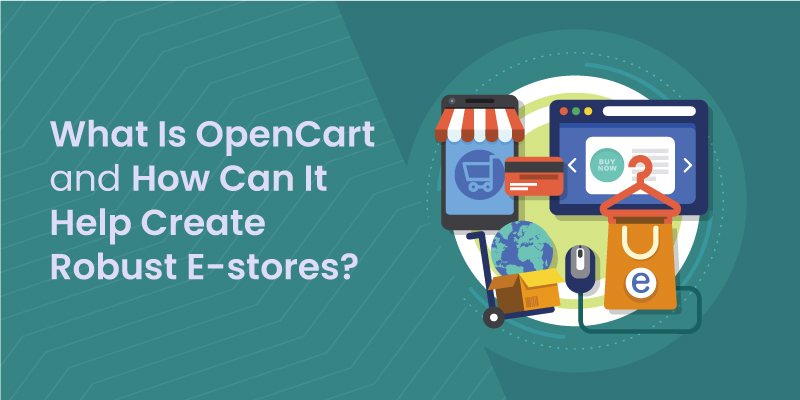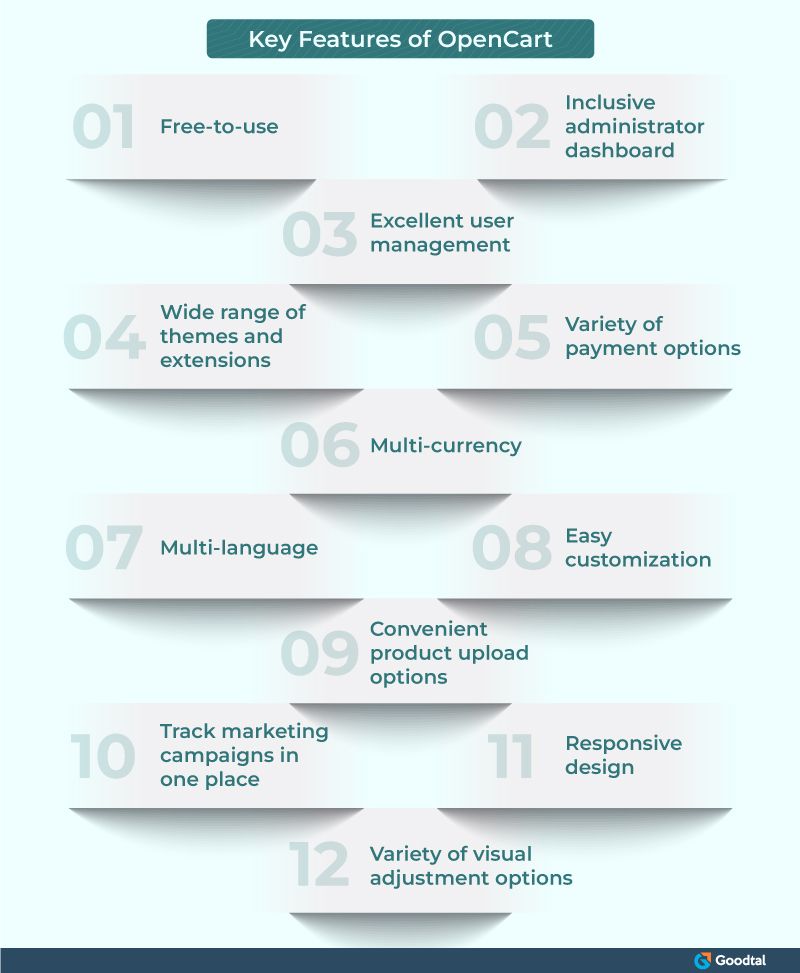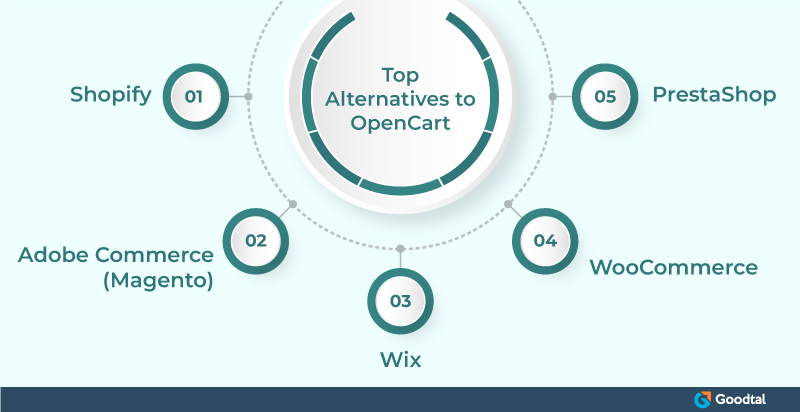
As digitalization reaches every nook and cranny of this world, we are moving more towards the “virtual” or "online" world. This movement has led to a significant rise in online shopping, thus leading to exponential growth in the market value of the ecommerce industry.
Today, in this post, we will talk about an ecommerce building platform that is helping leading ecommerce developers create appealing and robust ecommerce websites in minimal time. We will talk about OpenCart, a leading ecommerce platform used by some of the best ecommerce developers worldwide.
We will discuss OpenCart’s key features and how businesses leverage them to create powerful ecommerce platforms in minimal time and cost-effectively. So, let's move forward and begin by getting a brief overview of OpenCart.
A Brief Overview of OpenCart
OpenCart was first released in 1999 and has been a popular choice for ecommerce developers and service seekers worldwide. Hong Kong-based OpenKart Limited launched this free-to-use platform.
It is an open-source ecommerce platform written in PHP with MySQLi database and HTML components. Some leading ecommerce developers worldwide are using this platform to build e-stores and for better online store and database management.
Let's look at some of the key features of this ecommerce platform in detail.
Key Things to Note About OpenCart
OpenCart boasts many robust features, making it one of the most developer, administrator, and e-commerce-friendly tools for ecommerce development. Let's briefly discuss some of the most important features of OpenCart.

#1 Inclusive Administrator Dashboard
When handling an e-commerce business, administrators need to monitor a range of parameters constantly in real-time to ensure the smooth running of their e-store. To do this, the administrators need access to super-inclusive dashboards, which allow them to observe everything related to the store. These parameters include traffic insights, buyer metrics, inventory conditions, total orders, number of people online, etc.
OpenCart provides ecommerce owners with a robust administrator dashboard to monitor accurate and real-time information about everything happening in the ecommerce platform.
#2 Excellent User Management
OpenCart allows administrators to manage the e-commerce platform's user base easily. To clarify, we are not talking about the visitors but the users from the business side who have access to the platform's backend. With OpenCart's seamless user management, administrators can easily control the access of particular platform areas.
They can grant or remove the user's access to particular areas using OpenCart's user management panel. This way, the platform makes it easier for administrators to manage access to various platform areas.
#3 Range of Themes and Extensions
OpenCart provides a wide range of themes and extensions to ecommerce developers to build e-stores. Based on the official website, OpenCart offers more than 13,000 themes and extensions for ecommerce developers to use and build unique e-stores.
#4 Provides a Wide Variety of Payment Options
To make it easier for customers to shop, OpenCart provides a wide range of payment options for ecommerce businesses to add to their platforms, accounting for about 36 payment methods. These payment options include credit cards, debit cards, net banking, PayPal, Amazon Payments, and other leading payment channels.
Suggested Reading: Buy Now Pay Later: A Step Towards Making Online Shopping More Customer Friendly
#5 Free-to-use
OpenCart is a free-to-use e-commerce building platform for download and use. It comes with various excellent and free-to-use themes, extensions, and modules for ecommerce developers. This is a wonderful initiative for new learners trying to learn this platform and for local store owners willing to launch their e-store on a minimal budget.
#6 Multi-Language
OpenCart enables ecommerce developers to make multilingual ecommerce platforms to increase the audience range and demography. Ecommerce developers can access over 40 languages, including Chinese, Japanese, English, Spanish, Arabic, Hebrew, and many more.
#7 Multi-Currency
OpenCart enables ecommerce developers to add multiple currency options to their ecommerce platform to make it easier for customers to know the price of commodities in their local currencies. The multi-currency mechanism of OpenCart makes it easier for ecommerce merchants to add various currencies without worrying about setting the rates, as OpenCart automatically adjusts the prices and taxes based on its calculation.
#8 Easy Customization
One of the best things about OpenCart is that building e-stores and customizing them is super-easy or hassle-free. One of the key reasons behind easy customization in OpenCart is its open-source nature, making customizing easier than other closed-source alternatives.
#9 Convenient Product Upload Options
OpenCart gives e-store administrators two options to choose from while uploading products. First, they can either upload products one by one (one product at a time) or choose to upload many products in bulk at one time.
The best thing about OpenCart is that there is no limit to the number of products you can upload to your e-store. Depending on your business needs, your e-store can sell just one product or hundreds of thousands of products.
#10 Track Your Marketing Campaigns
OpenCart provides a separate marketing section in the ecommerce platform for the administrators to monitor their marketing campaigns. Through the marketing section present in the OpenCart dashboard, digital marketers can easily add a new marketing campaign or track their existing ones. You can get all the sales and traffic analytics by visiting the marketing dashboard. Thus allowing you to monitor individually the impact of different marketing campaigns.
#11 Responsive Platform
One of the biggest perks of ecommerce developers using OpenCart is that the e-stores they build using the platform have a responsive web design. Responsivity is the crucial feature of OpenCart, which helps developers provide e-stores that look and feel the same on every device, be it mobile, desktop, or tablet, thereby improving the visitor experience.
#12 Variety of Visual Adjustment Options
In a boost to building a customizable ecommerce platform, OpenCart provides ecommerce developers a free hand to make their e-store look visually appealing. They can easily play with many font styles, rich color palettes, and other visual elements provided to them and create a unique and attractive e-store in minimal time and cost.
The features discussed above are the most important reasons top OpenCart developers are clung to this e-commerce platform and keep using it to deliver the best and most unique e-stores to clients worldwide.
Some Drawbacks of OpenCart
Like every coin has two sides, OpenCart has a healthy number of perks that attract ecommerce developers worldwide, but it also has some drawbacks, which clients and developers should know.

#1 Technical Skills Required
One of the key drawbacks of OpenCart is that it is not a friendly platform for people with no technical skills. Hence, amateurs can not use this platform to create e-stores. One needs to have technical proficiency and, in particular, good knowledge of PHP, the language in which OpenCart is written. Additionally, PHP is known to be one of the most challenging languages to learn.
#2 Additional Hidden Costs
Another drawback of OpenCart is the hidden costs that one has to pay to extend the functionalities of the e-store. And sometimes, you might have to pay a higher price than expected for scaling your e-store.
Top Alternatives to OpenCart
Now, I hope you've got a better understanding of OpenCart and the benefits of using it. Let's move forward and talk about some key alternatives of OpenCart that you should also consider.

- Shopify:
Shopify, founded in 2006 in Canada, is a popular ecommerce solution loved and the first choice of ecommerce developers worldwide. It has a rich library of best-in-class themes, extensions, modules, and APIs. Shopify usage plans come in easy-to-afford packages segregated into three plans: basic, premium, and advanced. Note: Unlike OpenCart, Shopify plans come with Shopify's web hosting.
- WooCommerce:
WooCommerce, launched in 2011, is a WordPress-based open-source ecommerce platform. If you are looking to build an e-store, WooCommerce is for you, and if you are looking forward to using WooCommerce as a business solution to make e-stores, WooCommerce is for you. WooCommerce powers more than 4 million active e-stores around the world.
- Wix
Wix is an Israel-based company founded in 2006 known to provide robust digital solutions. Wix is highly popular for its e-commerce solutions, with free and affordable plans that do not exceed $59 monthly.
- Adobe Commerce/Magento:
Magento, now renamed Adobe Commerce, was launched in 2008 as an open-source ecommerce platform packed with some of Adobe's best tools. eCommerce developers can use trending technologies like AI to boost customization and customer experience.
- PrestaShop:
Like OpenCart, Prestashop is a free-to-use open-source ecommerce platform written in PHP. It is known for its quality of customer support, marketing, and SEO, which is the point where it outperforms OpenCart. But when it comes to pricing, themes, and design elements, OpenCart stands far ahead of PrestaShop.
Suggested Reading: Here’s Why You Should Prioritize Customer Service in Your Ecommerce Business?
Summing Up
With the world becoming increasingly digitalized today, almost everything is going on the internet, a.k.a. online, and so have our shopping habits. With the increasing market size of ecommerce, more and more people are starting to invest in it, thus leading to greater competition. In these times, it has become crucial for every physical chain to invest in an e-store solution.
We discussed OpenCart, an e-commerce development platform that helps businesses build a unique and robust e-store in minimal time and cost. This ecommerce solution is free to use, open-source, highly efficient, and quick to learn the key reasons behind the massive popularity of OpenCart.
We looked at some of the most defining features of this platform, along with some of its key drawbacks. We also briefly discussed some of OpenCart's key alternatives. It is essential to have the information provided in the blog for every e-commerce development service seeker to choose the best solution and service provider that could help them create the best e-store for them.
